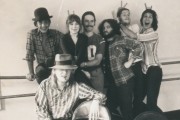 Big Eyes is based on the true story of Margaret Keane (Amy Adams), an artist who became known in the 1960s for dozens of paintings of big-eyed waifs, which practically created the pop art reproduction industry. However, Margaret didn’t become known as the creator of these paintings until years after — because her husband Walter Keane (Christoph Waltz), an affable salesman, took credit for the paintings, turning him into a celebrity and a millionaire. Margaret reluctantly goes along with her husband’s scheme because of the money they are making and his threats against her life (and the life of her daughter from a previous marriage), but as she becomes increasingly strong-willed she realizes that credit should be given where it is really due.
Big Eyes is based on the true story of Margaret Keane (Amy Adams), an artist who became known in the 1960s for dozens of paintings of big-eyed waifs, which practically created the pop art reproduction industry. However, Margaret didn’t become known as the creator of these paintings until years after — because her husband Walter Keane (Christoph Waltz), an affable salesman, took credit for the paintings, turning him into a celebrity and a millionaire. Margaret reluctantly goes along with her husband’s scheme because of the money they are making and his threats against her life (and the life of her daughter from a previous marriage), but as she becomes increasingly strong-willed she realizes that credit should be given where it is really due.
Despite opening on a picturesque 1950s suburban sprawl reminiscent of the neighborhood in Edward Scissorhands, Big Eyes is a major departure for Burton. It is his most conventional and reality-based film, which is not surprising after the critical and commercial disappointment of Dark Shadows. For instance, it’s Burton’s first live action movie without Helena Bonham Carter since Sleepy Hollow and his first without Johnny Depp since Big Fish — in fact, the cast features none of Burton’s regulars. Nonetheless, Burton has retained a number of his behind-the-scenes favorites for Big Eyes: composer Danny Elfman, costume designer Colleen Atwood, production designer Rick Heinrichs, executive producer/assistant director Katterli Frauenfelder, executive producer Derek Frey, and Dark Shadows cinematographer Bruno Delbonnel. Even the screenwriters are Burton veterans — Scott Alexander and Larry Karaszewski penned the script for Ed Wood, which appropriately enough was the last Burton film to be based on the life of a real person.
Nonetheless, despite Burton using many of his collaborators in this capacity, Big Eyes doesn’t feel like a traditional Tim Burton film. While that’s better than when Burton gets too kooky — like in Dark Shadows — the pendulum has swung in the other direction, resulting in a film that lacks a unique stamp. One could argue that it is the oddest Tim Burton film because it isn’t like a Tim Burton film at all.
Ignoring all that and considering Big Eyes as a film, the big draw here is Waltz’ performance. Waltz paces through this film with a smile that becomes toothier by the minute, eventually turning him into a scenery-chewing eccentric by the end of the film. He vastly overshadows Adams just by sheer force of personality. That isn’t a knock against her as an actress since her Margaret is full of wide-eyed hurt and Tennessee charm, and the character isn’t meant to be an assertive woman for most of the film. So while this film is generally supposed to be a biopic of Margaret, it’s Waltz’s Walter who steals the spotlight.
Jason Schwartzman appears in a small role as a snooty art gallery owner which is obviously a perfect role for Schwartzman, and Krysten Ritter appears in an even smaller role as Margaret’s free-spirited friend and confidant DeeAnn. But the real focus here is on Waltz, and while he’s obviously a strong enough actor to carry a movie on his own, one great performance doesn’t really make a film particularly good.
Big Eyes isn’t a bad film, but it’s certainly the oddest movie in the filmography of Tim Burton simply because it’s so… normal. I understand why Burton might want to play it safe after Dark Shadows, but Big Eyes really lacks the spirit that makes Burton’s films so wonderful. Ed Wood proved that Burton could tackle real-life subjects in his own unique style, and there is definitely a much better movie somewhere in this material that didn’t get made.
Rating: Though built around a truly entertaining performance by Christoph Waltz, Big Eyes is too pedestrian to make a real impact about its subject (6/10).
















Recent Comments